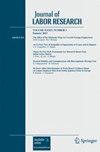按入职年份和入职前工资行业附着情况分列的自营职业持续时间差异
IF 1
4区 管理学
Q3 INDUSTRIAL RELATIONS & LABOR
引用次数: 0
摘要
有关自雇人士的文献提出了两种不同的自雇途径。一方面,自雇与创业精神和追求机会的动机有关。另一方面,以往的研究表明,人们之所以成为自雇人士,也是因为工资部门的机会有限。本文使用一组独特的数据,将美国社区调查与 1040 表格和 W-2 记录联系起来,通过研究连续五批入职人群的自雇持续时间(包括在大衰退期间入职的两批人群),对现有文献进行了扩展。严重受限的劳动力市场机会可能促使许多在经济衰退期间进入自雇行业的人进入自雇行业,而在经济繁荣期间进入自雇行业的人可能是在有利的市场条件下寻找机会。为了更明确地检验 "必要性 "自雇与 "机会性 "自雇的概念,我们还研究了自雇人员进入劳动力市场前的工资依附关系。具体来说,我们询问工资劳动依附性与自雇持续时间之间是否存在关联。我们还探讨了这两批人的人口/社会经济特征和自雇退出行为是否不同,如果不同,又是如何不同的。我们发现了与 "必要性 "和 "机会性 "自雇类型存在一致性的证据。即使控制了当地的经济条件和自雇人员的人口/社会经济特征,与工资劳动力市场联系更紧密的自雇人员退出自雇的时间更早,而且更有可能从自雇过渡到失业。本文章由计算机程序翻译,如有差异,请以英文原文为准。
Differences in Self-Employment Duration by Year of Entry & Pre-Entry Wage-Sector Attachment
The literature on the self-employed hypothesizes two different paths to self-employment. On the one hand, self-employment is associated with entrepreneurship and a motivation to pursue an opportunity. On the other hand, previous research indicates that people also become self-employed because of limited opportunities in the wage sector. Using a unique set of data that links the American Community Survey to Form 1040 and W-2 records, this paper extends the existing literature by examining self-employment duration for five consecutive entry cohorts, including two cohorts who entered self-employment during the Great Recession. Severely limited labor market opportunities may have driven many in the recession cohorts to enter self-employment, while those entering self-employment during the boom may have been pursuing opportunities under favorable market conditions. To more explicitly test the concept of “necessity” versus “opportunity” self-employment, we also examine the pre-entry wage labor attachment of entrants. Specifically, we ask whether an association exists between wage labor attachment and the duration of self-employment. We also explore whether the demographic/socio-economic characteristics and self-employment exit behavior of the cohorts are different, and if so, how. We find evidence consistent with the existence of “necessity” vs. “opportunity” self-employment types. Even when controlling for local economic conditions and the demographic/socio-economic characteristics of the self-employed, entrants with a more tenuous connection to the wage labor market exit self-employment earlier, and are more likely to transition from self-employment to unemployment.
求助全文
通过发布文献求助,成功后即可免费获取论文全文。
去求助
来源期刊

Journal of Labor Research
INDUSTRIAL RELATIONS & LABOR-
CiteScore
1.50
自引率
12.50%
发文量
12
期刊介绍:
Mission Statement
The Journal of Labor Research provides an outlet for original research on all aspects of behavior affecting labor market outcomes. The Journal provides a forum for both empirical and theoretical research on labor economics. The journal welcomes submissions issues relating to labor markets and employment relations, including labor demand and supply, personnel economics, unions and collective bargaining, employee participation, dispute resolution, labor market policies, types of employment relationships, the interplay between labor market variables and policy issues in labor economics are published by the Journal. The Journal of Labor Research also publishes book reviews relating to these topics.
 求助内容:
求助内容: 应助结果提醒方式:
应助结果提醒方式:


